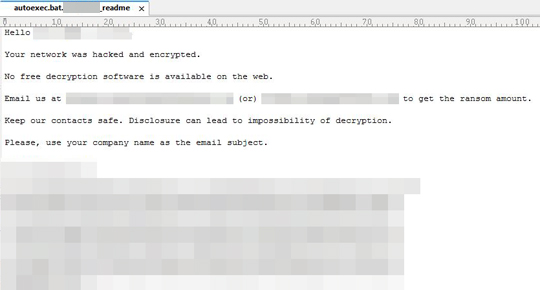Ransom.Win32.BITPAYMER.TGACAM
Trojan.Win32.DelShad.bjq (KASPERSKY); W32/DelShad.BJQ!tr.ransom (FORTINET)
Windows


Threat Type: Ransomware
Destructiveness: No
Encrypted: Yes
In the wild: Yes
OVERVIEW
This Ransomware arrives on a system as a file dropped by other malware or as a file downloaded unknowingly by users when visiting malicious sites.
It deletes the initially executed copy of itself.
It drops files as ransom note. It avoids encrypting files with the following file extensions.
TECHNICAL DETAILS
Arrival Details
This Ransomware arrives on a system as a file dropped by other malware or as a file downloaded unknowingly by users when visiting malicious sites.
Installation
This Ransomware drops and executes the following files:
- %Application data%\{random}:bin -> Alternate Data Stream copy
It adds the following processes:
- %Application Data%\{random}:bin {malware path}\{malware name}.exe
- %System%\vssadmin.exe Delete Shadows /All /Quiet - to delete shadow copies
- %System%\diskshadow.exe /s %User Temp%\{random}.tmp - to delete shadow copies
(Note: %Application Data% is the current user's Application Data folder, which is usually C:\Documents and Settings\{user name}\Application Data on Windows 2000(32-bit), XP, and Server 2003(32-bit), or C:\Users\{user name}\AppData\Roaming on Windows Vista, 7, 8, 8.1, 2008(64-bit), 2012(64-bit) and 10(64-bit).. %System% is the Windows system folder, where it usually is C:\Windows\System32 on all Windows operating system versions.. %User Temp% is the current user's Temp folder, which is usually C:\Documents and Settings\{user name}\Local Settings\Temp on Windows 2000(32-bit), XP, and Server 2003(32-bit), or C:\Users\{user name}\AppData\Local\Temp on Windows Vista, 7, 8, 8.1, 2008(64-bit), 2012(64-bit) and 10(64-bit).)
Other Details
This Ransomware does the following:
- It deletes the dropped alternate data stream copy %Application Data%\{random}:bin after execution.
- It does the following if it is not ran with administrative rights:
- Adds the following files:
- %User Temp%\{random}.cmd -> command to start malware without prompt
- Adds the following registry entries:
- HKEY_CLASSES_ROOT\MSCFile\shell\open\command
- = %system%\cmd.exe %User temp%\{random}.cmd
- Run %System%\eventvwr.exe to execute the malware
- It deletes both the added registry and dropped cmd file after execution
- It adds the following processes to obtain and map network and logical drivers, and encrypt the files in said drivers:
- %System%\arp.exe -a
- %System%\nslookup.exe {ip address}
- It looks for a legitimate service to hijack using the following:
- %System%\takeown.exe /F {service path}\{service name}.exe
- %System%\icacls.exe {service path}\{service name}.exe /reset
- After successfully hijacking the service, it will use alternate data stream and rename the legitimate service as {service name}:0. It will then rename itself as the hijacked service's name.
(Note: %Application Data% is the current user's Application Data folder, which is usually C:\Documents and Settings\{user name}\Application Data on Windows 2000(32-bit), XP, and Server 2003(32-bit), or C:\Users\{user name}\AppData\Roaming on Windows Vista, 7, 8, 8.1, 2008(64-bit), 2012(64-bit) and 10(64-bit).. %System% is the Windows system folder, where it usually is C:\Windows\System32 on all Windows operating system versions.)
It deletes the initially executed copy of itself
Ransomware Routine
This Ransomware avoids encrypting files with the following strings in their file path:
- Caches
- WindowsApps
- System Volume Information
- AppData
- WebCache
- $RECYCLE.BIN
It avoids encrypting files found in the following folders:
- %Windows%
- %User Temp%
- %Application Data%
(Note: %Windows% is the Windows folder, where it usually is C:\Windows on all Windows operating system versions.. %User Temp% is the current user's Temp folder, which is usually C:\Documents and Settings\{user name}\Local Settings\Temp on Windows 2000(32-bit), XP, and Server 2003(32-bit), or C:\Users\{user name}\AppData\Local\Temp on Windows Vista, 7, 8, 8.1, 2008(64-bit), 2012(64-bit) and 10(64-bit).. %Application Data% is the current user's Application Data folder, which is usually C:\Documents and Settings\{user name}\Application Data on Windows 2000(32-bit), XP, and Server 2003(32-bit), or C:\Users\{user name}\AppData\Roaming on Windows Vista, 7, 8, 8.1, 2008(64-bit), 2012(64-bit) and 10(64-bit).)
It appends the following extension to the file name of the encrypted files:
- .{BLOCKED}bh
It drops the following file(s) as ransom note:
- {encrypted directory}\{encrypted file's name}.{BLOCKED}mbh_readme:

It avoids encrypting files with the following file extensions:
- .exe
- .dll
- .{BLOCKED}bh
- .{BLOCKED}bh_readme
SOLUTION
Step 1
Trend Micro Predictive Machine Learning detects and blocks malware at the first sign of its existence, before it executes on your system. When enabled, your Trend Micro product detects this malware under the following machine learning name:
-
Troj.Win32.TRX.XXPE50FFF032
Step 2
Before doing any scans, Windows 7, Windows 8, Windows 8.1, and Windows 10 users must disable System Restore to allow full scanning of their computers.
Step 3
Note that not all files, folders, and registry keys and entries are installed on your computer during this malware's/spyware's/grayware's execution. This may be due to incomplete installation or other operating system conditions. If you do not find the same files/folders/registry information, please proceed to the next step.
Step 4
Search and delete these files
- {encrypted directory}\{encrypted file's name}.{BLOCKED}bh_readme
Step 5
Scan your computer with your Trend Micro product to delete files detected as Ransom.Win32.BITPAYMER.TGACAM. If the detected files have already been cleaned, deleted, or quarantined by your Trend Micro product, no further step is required. You may opt to simply delete the quarantined files. Please check the following Trend Micro Support pages for more information:
Step 6
Restore encrypted files from backup.
NOTES:
Do the following after Step 3:
- Before rebooting the system, download streams from systerinternals.
- Extract it under the Desktop directory.
- Reboot the system under Safe Mode with Command Line.
- Once the cmd is running type the following commands (under desktop directory):
- - streams -s %APPDATA% - Verify if there's a file with :bin ADS name.
- - streams -s -d %APPDATA% - delete the malicious ads file.
- - streams -s C:\Windows - Verify if there's a file with :0 ADS name. Take note of the path.
- - expand %Service File%:0 %Service File% - this will restore the original file. ie. expand C:\Windows\System32\alg.exe:0 C:\Windows\System32\alg.exe
- - streams -s C:\Windows - to verify if there's other ADS.
- - streams -s -d C:\Windows - to delete the rest of the malicious ADS. (mostly prefetch files).
- Reboot the system
Did this description help? Tell us how we did.


